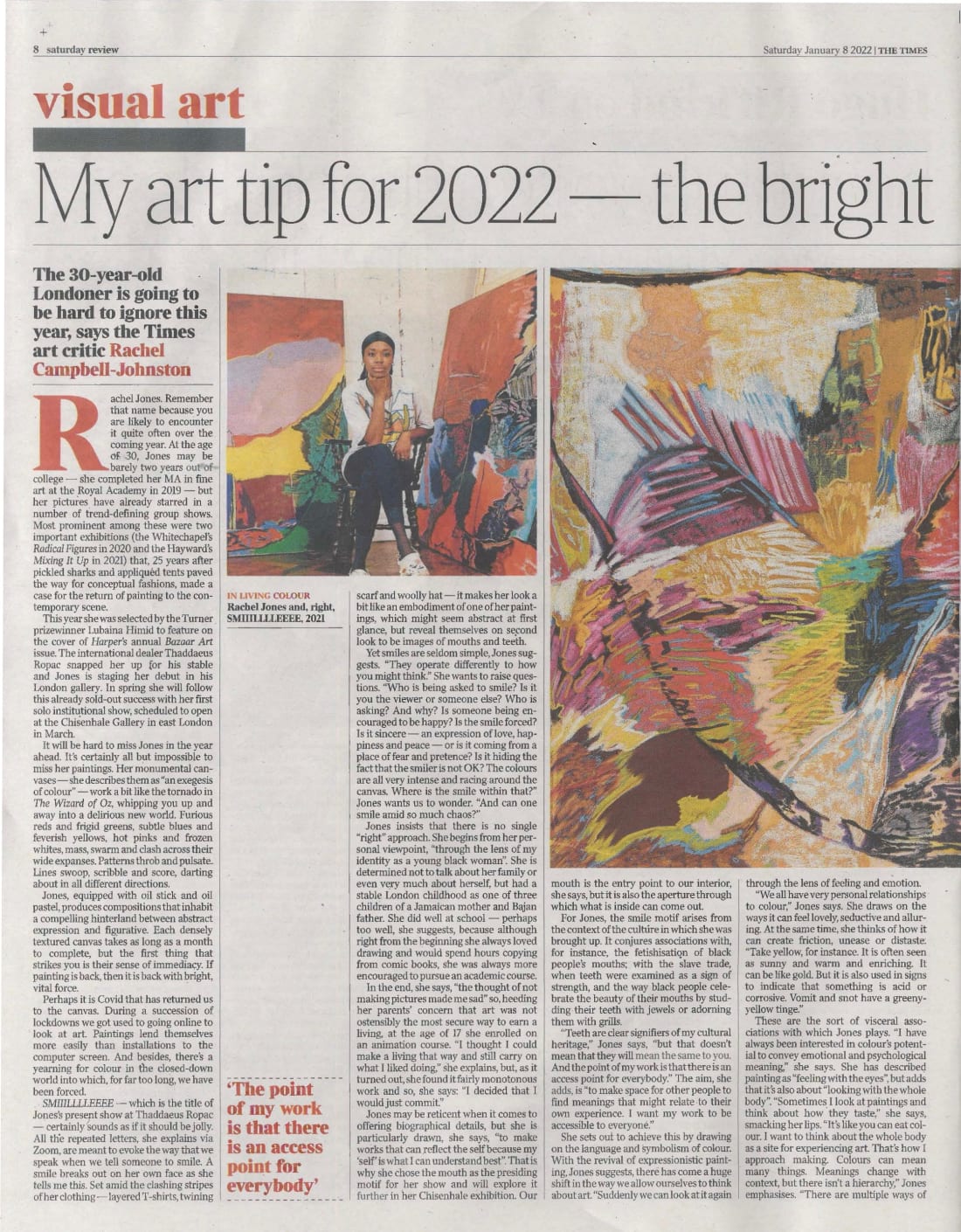Rachel Jones. Remember that name because you are likely to encounter it quite often over the coming year. At the age of 30, Jones may be barely two years out of college — she completed her MA in fine art at the Royal Academy in 2019 — but her pictures have already starred in a number of trend-defining group shows.
This year she was selected by the Turner Prize winner Lubaina Himid to feature on the cover of Harper’s annual Bazaar Art issue. The international dealer Thaddaeus Ropac snapped her up for his stable and Jones is staging her debut in his London gallery. In spring she will follow this already sold-out success with her first solo institutional show, scheduled to open at the Chisenhale Gallery in east London in March.
It will be hard to miss Jones in the year ahead. It’s certainly all but impossible to miss her paintings. Her monumental canvases — she describes them as “an exegesis of colour” — work a bit like the tornado in The Wizard of Oz, whipping you up and away into a delirious new world. Furious reds and frigid greens, subtle blues and feverish yellows, hot pinks and frozen whites, mass, swarm and clash across their wide expanses. Patterns throb and pulsate. Lines swoop, scribble and score, darting about in all different directions.
Jones, equipped with oil stick and oil pastel, produces compositions that inhabit a compelling hinterland between abstract expression and figurative. Each densely textured canvas takes as long as a month to complete, but the first thing that strikes you is their sense of immediacy. If painting is back, then it is back with bright, vital force.
Perhaps it is Covid that has returned us to the canvas. During a succession of lockdowns we got used to going online to look at art. Paintings lend themselves more easily than installations to the computer screen. And besides, there’s a yearning for colour in the closed-down world into which, for far too long, we have been forced.
SMIIILLLLEEEE — which is the title of Jones’s present show at Thaddaeus Ropac — certainly sounds as if it should be jolly. All the repeated letters, she explains via Zoom, are meant to evoke the way that we speak when we tell someone to smile. A smile breaks out on her own face as she tells me this. Set amid the clashing stripes of her clothing — layered T-shirts, twining scarf and woolly hat — it makes her look a bit like an embodiment of one of her paintings, which might seem abstract at first glance, but reveal themselves on second look to be images of mouths and teeth.
Yet smiles are seldom simple, Jones suggests. “They operate differently to how you might think.” She wants to raise questions. “Who is being asked to smile? Is it you the viewer or someone else? Who is asking? And why? Is someone being encouraged to be happy? Is the smile forced? Is it sincere — an expression of love, happiness and peace — or is it coming from a place of fear and pretence? Is it hiding the fact that the smiler is not OK? The colours are all very intense and racing around the canvas. Where is the smile within that?” Jones wants us to wonder. “And can one smile amid so much chaos?”
Jones insists that there is no single “right” approach. She begins from her personal viewpoint, “through the lens of my identity as a young black woman”. She is determined not to talk about her family or even very much about herself, but had a stable London childhood as one of three children of a Jamaican mother and Bajan father. She did well at school — perhaps too well, she suggests, because although right from the beginning she always loved drawing and would spend hours copying from comic books, she was always more encouraged to pursue an academic course.
In the end, she says, “the thought of not making pictures made me sad” so, heeding her parents’ concern that art was not ostensibly the most secure way to earn a living, at the age of 17 she enrolled on an animation course. “I thought I could make a living that way and still carry on what I liked doing,” she explains, but, as it turned out, she found it fairly monotonous work and so, she says: “I decided that I would just commit.”
Jones may be reticent when it comes to offering biographical details, but she is particularly drawn, she says, “to make works that can reflect the self because my ‘self’ is what I can understand best”. That is why she chose the mouth as the presiding motif for her show and will continue to explore it in her Chisenhale exhibition. Our mouth is the entry point to our interior, she explains, but it is also the aperture through which what is inside can come out.
For Jones, the smile motif arises from the context of the culture in which she was brought up. It conjures associations with, for instance, the fetishisation of black people’s mouths; with the slave trade, when teeth were examined as a sign of strength, and the way black people celebrate the beauty of their mouths by studding their teeth with jewels or adorning them with grills.
“Teeth are clear signifiers of my cultural heritage,” Jones says, “but that doesn’t mean that they will mean the same to you. And the point of my work is that there is an access point for everybody.” The aim, she adds, is “to make space for other people to find meanings that might relate to their own experience. I want my work to be accessible to everyone.”
She sets out to achieve this by drawing on the language and symbolism of colour. With the revival of expressionistic painting, Jones suggests, there has come a huge shift in the way we allow ourselves to think about art. “Suddenly we can look at it again through the lens of feeling and emotion.
“We all have very personal relationships to colour,” Jones says. She draws on the ways it can feel lovely, seductive and alluring. At the same time, she thinks of how it can create friction, unease or distaste. “Take yellow, for instance. It is often seen as sunny and warm and enriching. It can be like gold. But it is also used in signs to indicate that something is acid or corrosive. Vomit and snot have a greeny-yellow tinge.”
These are the sort of visceral associations with which Jones plays. “I have always been interested in colour’s potential to convey emotional and psychological meaning,” she says. She has described painting as “feeling with the eyes”, but adds that it’s also about “looking with the whole body”. “Sometimes I look at paintings and think about how they taste,” she says, smacking her lips. “It’s like you can eat colour. I want to think about the whole body as a site for experiencing art. That’s how I approach making.
“Colours can mean many things. Meanings change with context, but there isn’t a hierarchy,” Jones emphasises. “There are multiple ways of experiencing and understanding, and all are as valid as each other. Teeth can be beautiful, but they are also bits of exposed bone. That might feel ugly or horrifying, but the beauty and the ugliness are both vital. You can’t have one without the other. To have only the lovely would be to have a very restricted vision. It would be to deny that which is vital to the ways in which we can relate to each other; we can only understand each other by sharing everything, sharing the lovely and the not-so-lovely. That’s how we grow and develop and understand.”
A desire for mutual understanding underpins Jones’s vision. She likes to work with diverse communities. She enjoys collaborations. She has done performances in media other than paint — most notably music, when she staged a karaoke night. She is also a teacher at the Royal Drawing School.
“I just like people,” she declares. “All sorts of people. I like to surround myself with people who are alike to me and people who are different to me. One of the best things about being human is that we are social. And in lives that are so often full of routine and structure I like to create moments that can take us beyond, into places which feel more open to expression and thoughtfulness and stillness.” These are the places where, she believes, we can get in touch with the reality of “being a person”.
Jones offers a vision of a future community in which all different voices can be integrated, developed, accepted and understood. Her exuberant pieces are alive with her optimism. As far as her own future is concerned, she hasn’t got her heart set on the artist’s conventional course. She dreams less of winning the Turner prize than of having children and settling down on a farm to raise animals and tend a vegetable garden. Yet “everything I make comes, fundamentally, from a place of love and joy. And when I use the word ‘joy’, I mean peace and hopefulness and purpose,” she proclaims. That gives us all something to smile about in the year ahead.





















































































































































































